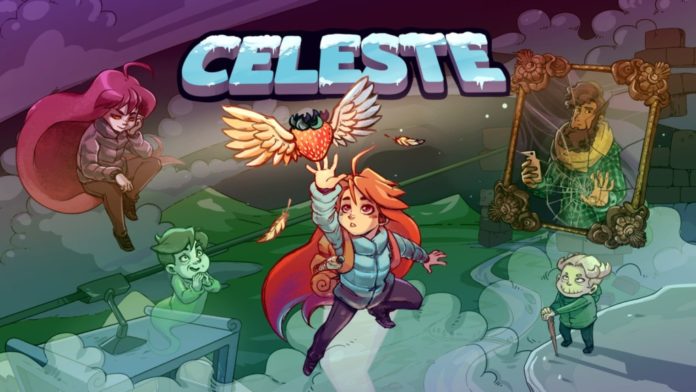A product of our increasingly interconnected world, Celeste was created by Canadian Matt Thorson and his team in Vancouver, featuring Brazilian studio MiniBoss’s crafted art and Seattle’s Lena Raine’s new soundtrack. Celeste’s plot is equally universal: Madeline, the game’s protagonist, attempts to climb Mount Celeste, encountering both obstacles and pleasant surprises along the way. However, Madeline suffers from anxiety and depression, a struggle which most modern video games do not typically include, and the game chronicles her struggle as she seeks catharsis while ascending the mountain, pursuing the emotional healing and spiritual peace she hopes to find at the top of the climb.
Celeste, first released on January 25, 2018, caught my attention for a number of reasons. First, I’m a fan of platformers. Many recent games like Hollow Knight and Cuphead had platforming elements. The 3D platformers realm saw Mario Odyssey, N-Sane Trilogy, and Yooka-Laylee in just the last year. Nevertheless, the last true 2D platformer I played was Shovel Knight: Specter of Torment, so I was looking for something new. And Celeste, a high-skill, fast-paced 2D platformer/collectathon with lots of optional challenges and a fascinating central gimmick, certainly looked compelling. I also heard the game was very difficult and was looking forward to meeting its challenge.
What is so good about this game?
In brief, Celeste is a blast. Not since the first time I played a Souls game that kept me so engaged did I experienced hand cramps. The gameplay never loses momentum, with Madeline’s climbing, jumps, and wall-jumps making for riveting action. Madeline’s dashing ability is also of particular note; the dash, while simple on the surface, becomes re-contextualized by every new object, leading to great variety overall. The game rewards persistence and demands a certain level of precision. While no individual room is ever too difficult to parse, failure is a fact of life as you play Celeste, with perfect control and split-second timing necessary to advance.
What are the best objects in Celeste?
My favorite objects in the game are the voids from Chapter 2 because they have a very simple function, which leads to endless variety. You must enter the void by dashing, at which point your momentum is fixed until you exit, but then exiting refreshes your dash. This single object presents interesting challenges involving entering at the right angle with the right position, without using your dash until you are ready to enter. It’s a simple concept, yet the game ingeniously expands on the idea with chains of not only voids over pits but also voids that must be entered from multiple angles in the same room. Furthermore, a curious player will discover a jumping window once you exit the void, keeping your increased speed while adding extra height. While this technique merely makes some rooms of the default Chapter 2 much easier, it is required to beat the Chapter 2 B-Side, adding some fun mechanical complexity to the execution of that challenge. As unique as the voids are, every object in the game has a similar level of depth, and each chapter has a wide array of unique objects which combine in even more interesting ways.

What are some of the challenges players face in the game?
My favorite aspect of Celeste is the constantly escalating challenge. Each chapter features multiple strawberries, some hidden and some out in the open behind optional challenges. In addition, hidden in each level is one blue heart and one B-Side track. You need four blue hearts to unlock Chapter 8, the game’s epilogue, and each B-Side track unlocks an entirely new level, which is a harder version of the Chapter it’s found in and rewards you with a red heart. Collecting all eight blue hearts and seven red hearts unlocks the Chapter 8 B-Side and the final red heart, which still is not the true end of the game. Beating the Chapter 8 B-Side unlocks two additional challenges: C-Sides for all previous worlds, each rewarding a golden heart, and golden strawberries for each chapter’s A-Side. These items require you to complete the entire level without dying. Finishing all the C-Sides finally unlocks the Chapter 8 C-Side and the final golden heart. Despite all this content, the A-Sides alone are a significant and satisfying experience, and most players probably will not go farther than completing every B-Side, but I loved every minute of the game and relished completing each and every challenge.
Even if you don’t love video games, Celeste is noteworthy for its award-winning soundtrack. Honored as the “Video Game Score of the Year” for 2018 by the American Society of Composers, Authors and Publishers, Celeste’s music is compelling. Employing a balanced mix of piano and electronic instruments, the music is dreamy, ethereal even, adroitly illustrating Madeline’s struggles with anxiety. One of my favorite tracks is “Exhale,” embedded above. The soothing music blends a serene piano melody with light, airy notes that feel like magic, reminding the listener of Madeline’s journey, cautiously, yet hopefully, working to ascend the mountain before her.
Overall, you simply can’t miss with Celeste. With challenging gameplay, great art and a fascinating soundtrack, it’s well worth your time.
Final Review:
Like it? Love It? Gotta Have It!
Author’s Note: Celeste’s developers have just released a free DLC chapter, Chapter 9: Farewell. I have not commented on its gameplay or story here as I have not yet completed it or watched any videos about it, in the interest of not spoiling myself.
Stay tuned to The Roundup for more video game reviews!






